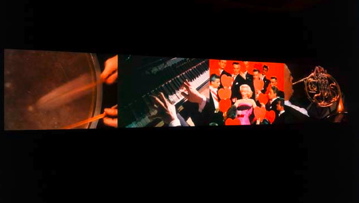
Christian Marclay, still from "Video Quartet," 2002
With the opening of Christian Marclay’s Video Quartet at the Nasher Museum of Art at Duke University (on view through July 26, 2009), I have been thinking about how to share this 14-minute video work of art with students.
For educators, I think there is often a reluctance to discuss video art on tours. Sometimes there are logistical issues in terms of time and sequencing, while at other times, the narrative of the video poses challenges. However, works like Video Quartet—videos that can be watched for a portion of time and then discussed—offer possibilities for meaningful exchanges with students and exposure to this medium.
I developed some strategies to discuss Video Quartet after hearing a talk from educator Denise Gray. In regards to looking at video art with students, she emphasized a structured interaction, such that it includes time to experience the work, as well as the conditions in which to discuss it. The discussion portion sometimes requires you to step away from the work, or even outside of the gallery where it is being shown. These comments might be helpful for talking about video art by Art21 artists Matthew Barney, Pierre Huyghe, Mike Kelley, and Paul Pfeiffer.
Before entering the gallery showing Video Quartet, I introduce students briefly to what they will see: a collage of over 700 film clips of sounds edited together by the artist Christian Marclay to create a musical composition—a quartet. I mention that they will watch about five minutes of this 15-minute work. I also ask students to look for something specific: the various ways in which sounds are made, as well as how the image of the sound fits with the recorded sound.
A recent group of eighth graders, upon viewing part of Video Quartet, discussed “traditional music,” and how combined sounds—such as those made by car horns, feet tapping, and glasses filled with water—also create a type of music. The musical possibilities of car horns caused many of them to view the sound in new ways.
Marclay’s process to create Video Quartet was also something they wanted to discuss. While they were familiar with collage, seeing a collage made with video allowed them to think about repetition and arrangement in new ways. One student said how she thought the four screens was a really engaging choice, and another commented on how the clips on different screens competed for his attention. Through this work, Marclay also demonstrates an interest in the memory that viewers may have with some of these movies—which is something else that the students picked up on, recognizing films including Back to the Future and The Addams Family.
In addition to talking with students about this work, we plan to facilitate a drawing activity for summer K-12 tours where students draw the pattern of a sound or sounds they choose to focus on, creating an alternate image to accompany the sound and image pairing that Marclay produced. At our May Family Day, we also had stations where students could experiment with the mixing and editing process, creating their own song using an application called Super Duper Music Looper.
In our media-saturated lives, Christian Marclay reminds us to question the relationships that we are presented with—the sounds and images edited together for films. I also feel he encourages viewers to think creatively about ways in which they can change their role from being a consumer to being a producer.
Julie Thomson is the Associate Curator of Education at the Nasher Museum of Art at Duke University where she develops materials for docents and teachers to use with K-12 audiences.




Pingback: Nasher Museum Blogs » Blog Archive » How to talk to students about video art